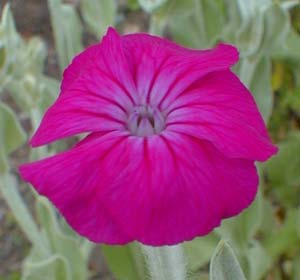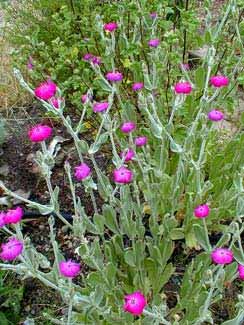 Rose Campion; or,
Rose Campion; or,
Dusty Miller; or,
Mullein Pink
Rose Campion (Lychnis coronaria) is an evergreen biennial in our low-maintenance roadside sungarden. The genus name means "Lamp" & alludes to the ancient use of the felt-like leaves as lamp wicks. The alternative name Dusty Miller is also the name of several other plants with fuzzy leaves.
In winter it consists only of the large wooly basal leaves are bluish-white in color. These very much resemble Lamb's Ears, but with undulations. In spring it sends up furry-leafed stalks to three feet tall which by late May have begun to produce the brightest rose-pink blossoms. The leaves of the stems are tiny compared to the basal leaves. Deadheading will encourage rebloom through most of summer.
 As a tender perennial or biennial, it fades away after three years, but frequently self-seeds to remain in the garden. For winter the stalks should all be cut close to the ground, preserving the basal leaves for a solid winter presence.
As a tender perennial or biennial, it fades away after three years, but frequently self-seeds to remain in the garden. For winter the stalks should all be cut close to the ground, preserving the basal leaves for a solid winter presence.The old-fashioned rose-pink has been a garden standard for centuries. Thomas Jefferson grew it in his childhood home at Shadwell, at a time when they were already a very old standards in England.
Native of northern Africa & southeastern Europe, it wants a sunny well-draining location. Here in the Northwest it is sometimes killed by rainy winters, so sharply draining soil is essential. It has a better chance of naturalizing on a rocky hillside garden where the roots won't be too wet for long at a time.
It also prefers limey soil, so it struggles a bit in our naturally acidic soils. I insert chalkboard sticks of calcium in the root mass for its first spring.
If conditions are anywhere close to what it likes, it will self-seed with abandon, but does not cast its seeds far, so some of the erupting seedlings may have to be weeded down around a declining parent.
Though tags typically recommend the flowers for bouquets, in reality cut flowers fade quickly, so are best left in the garden.